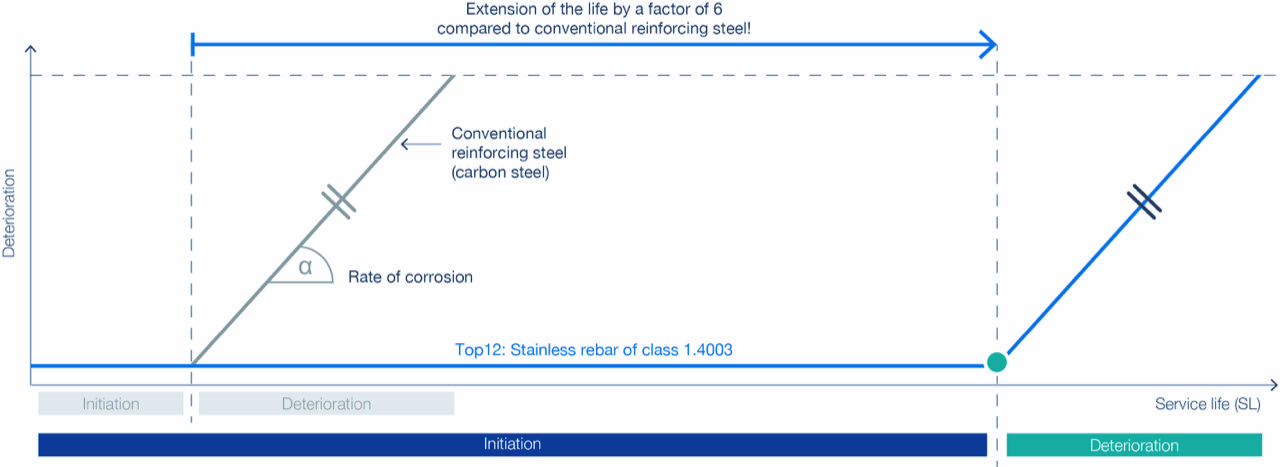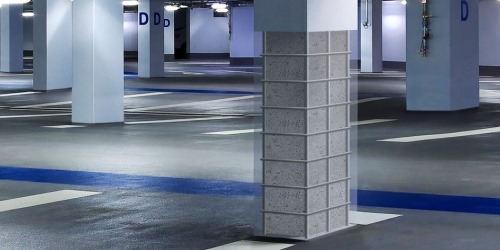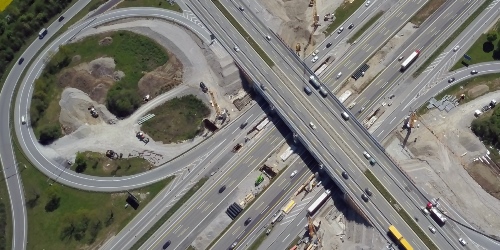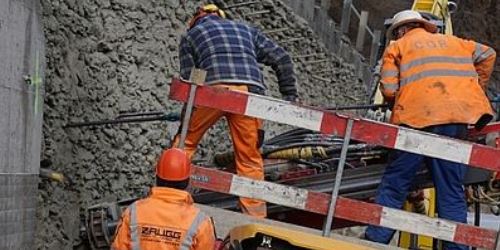Top12 STAINLESS REBAR
Best-in-class lifecycle costs in corrosive concrete environments
Top12 is an innovative reinforcing steel with significantly improved corrosion resistance and best-in-class lifecycle costs, developed by Steeltec in Switzerland. Top12:
- is a high-alloy class 1.4003 material and much more resistant to corrosion than conventional reinforcing steels because it contains at least 12 mass percent chromium.
- requires no special handling and can be conventionally processed.
- is approx. four times more resistant to chlorides than conventional reinforcing steel. This reliable protection from corrosion can extend the lifetime of structures many times over.
- requires only a very low concrete cover due to its higher corrosion resistance in case of chloride or CO2 attacks.
- In its geotechnical version with higher yield strength, it renders the usual sheathing tube of the anchor system redundant, as it provides the necessary protection for temporary and permanent anchors of protection level 2 in any ground - even in aggressive groundwater.
- High-alloy 1.4003 material
- Best-in-class life-cycle cost
- Ideal solution for many engineering and geotechnical applications
- Approvals in Germany and Switzerland
- > 1500 applications and successfully in use for > 20 years
- Steel bar
- Wire rod
- Anchors for geotechnics of protection level 2b
Durability tailored to operating needs
Corrosion caused by chlorides is the most common form of reinforcement corrosion. Chlorides penetrate the concrete and, above a certain chloride concentration on the reinforcement level, initiate corrosion. Depending on the corrosion resistance of the reinforcement, damage occurs faster or slower. This in turn is related to the alloy content and surface properties of the stainless steel. This means that the corrosion resistance of the steel can be influenced proactively. To improve the reliability and durability of structures and taking the overall costs into account, an optimized material selection is crucial. As the alloy content increases, not only the resistance of stainless steel increases, but also the material costs. The aim is to select the reinforcement according to the corrosion stress and the intended service life in a balanced cost-benefit ratio.
Best in class life-cycle costs for different structural applications
Cost reduction while ensuring high durability and robustness - a challenge to be solved more and more frequently while planning and repairing infrastructure buildings. With our stainless reinforcing steel Top12, we provide the answer. Top12 increases durability, offers practical construction advantages and keeps life cycle costs at the minimum.
| Component | Steel grade | Chloride
contamination [M.-%z] (Cs,Δx) |
Concrete
layer [mm] (µ/σ) |
Binder | Calculated lifetime [a] | Target lifetime [a] | |
| Bridge caps | non-alloy steel | 3,5 | 50 / 6 | CEM II/B-S | 14 | 50 | |
| Top12 | >100 | ||||||
| Bridge center columns | non-alloy steel | 3,0 | 55 / 8 | CEM II/B-S | 73 | 100 | |
| Top12 | +30kg/m2 FA | >>100 | |||||
| Tunnel emergency walkways | non-alloy steel | 5,0 | 50 / 6 | CEM II/B-S | 10 | 50 | |
| Top12 | 55 | ||||||
| Tunnel interior walls | non-alloy steel | 4,0 | 60 / 6 | CEM II/B-S | 68 | 100 | |
| Top12 | +30kg/m2 FA | >>100 |
Comparison of the different variants (standardized to Top12) with regard to life cycle costs - vertical axis cut off at 5.0
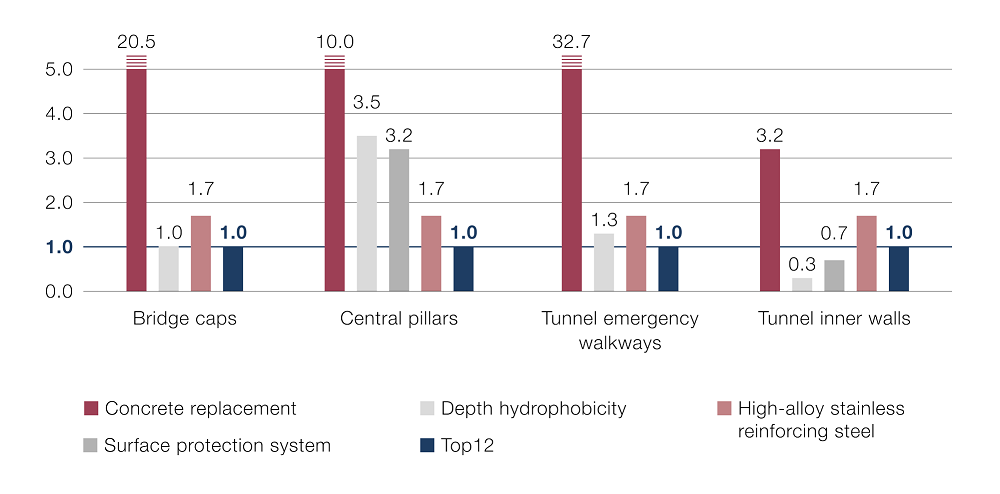
Top12: Technical data
Min. yield strengths (Rp0.2) expressed in N/mm²
| Product | Yield strength Rp0,2 | Yield to tensile strength ratio Rm/Rp0,2 | Elongation at max. load Agt | |||||
| [Mpa] | [ - ] | [ % ] | ||||||
| Top 12-500 | ≥ 500 | ≥ 1,08 | ≥ 5,0 | |||||
| Top12-670 | ≥ 670 | ≥ 1,08 | ≥ 5,0 | |||||
| Density in kg/dm2 | Electrical resistance at 20°C in (Ω mm2)/m | Magnetisa-bility | Thermal conductivity at 20°C in W/(m K) | Specific heat capacitiy at 20°C in J/(kg K) |
Young's modules in GPa at »20°C | Mean thermal expansion coefficient in 10-6K-1 »20°C - 100°C |
| 7.7 | 0.60 | yes | 25 | 430 | 210 | 10.40 |
| C | ||||||||
| Si | Mn | P | S | Cr | Ni | N | ||
| 0.015 | 0.70 | 0.50 | max. 0.025 | max. 0.005 | min. 12.00 | 0.50 | 0.02 | |
| Type | Top12-500 | Top12-670 |
| Wire rod (pickled, coiled) | Ø 8 / 10 / 12 / 14 mm | - |
| Steel bar (pickled) | - | Ø 16 / 20 / 28 / 36 / 43 mm |
Approvals and related applications for Top12
- DIN 488 (German standard): Top12 has two general building approvals from the German Institute for Building Technology (DIBt); approval number: Z-1.4-266; Z-1.4-272
- SIA 262 (Swiss standard): Top12-500 and Top12-670 are listed in the “Register normkonformer nichtrostender Betonstähle”.
Civil engineering and underground projects
- Caps and guide walls
- Retaining walls
- Bridge central pier
- Tunnel walls and portals
- Tunnel emergency walkway
- Pile caps and pile head beams
- Bored piles
Building construction projects
- Columns, walls, foundations of park buildings
- Precast concrete elements
- Sandwich elements
- Architectural concrete
As nails for:
- Excavation
- Slope stabilization
- Rock nails
- Tunnel construction
- Falling object protective structures
- Foundation plates
- Bridge foundations
- Foundation refurbishment
- Underpinning
- Buoyancy prevention
- Absorption of horizontal forces
Take a look at a field study how Top12 compares to other rebar steels
Corrosion results after 12 years under real conditions in an Alps road tunnel (concrete cover 10mm)
Field tests in the Naxberg tunnel in Switzerland have shown impressively how different steels behave under high but common chloride loads from road traffic. Both the unalloyed reinforcing steel and the galvanized reinforcing steel exhibited considerable pitting corrosion and each had a corroded steel surface of over 70%. Top12 showed small rust spots, but no measurable material erosion could be determined for these spots. The duplex steel showed no signs of corrosion and was still passive after 12 years.
| Conventional rebar |
Top12
with rolling skin |
Galvanized rebar |
Duplex
steel 1.4462 |
|
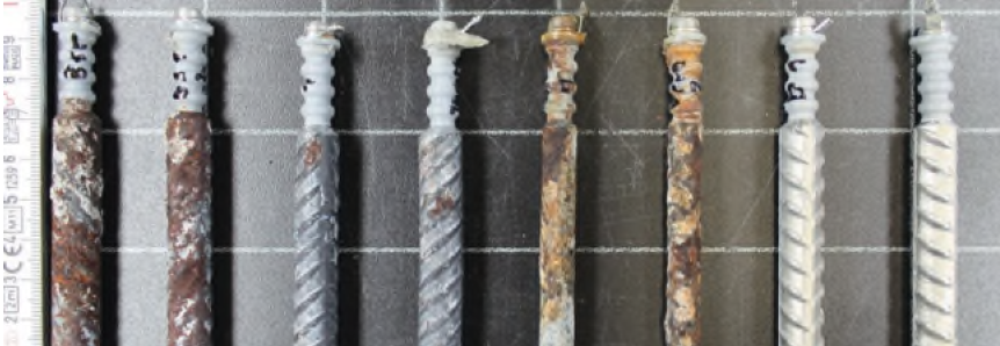
|
||||
Background knowledge: about the production of Top12
Top12 is approx. four times more resistant
The secret of the excellent mechanical-technological material properties and high corrosion resistance lies in the production of steel: a decisive factor is the selective addition of alloys in the steel melt, including more than 12 % chromium. The ribbed reinforcing steel is manufactured using a patented rolling process. After rolling, the steel is controlled and specifically cooled down to obtain its very good mechanical properties. In order to increase corrosion resistance in line with requirements, Steeltec pickles the Top12 after hot rolling - a further step to increase corrosion resistance by a factor of five. Pickling removes the so-called rolling skin. As a result, the bar surface is smoother and more homogeneous and the ribbed steel is protected against surface corrosion and pitting. Whereas the conventional, unalloyed reinforcing steel B500B withstands a chloride content of approx. 0.5% wt.%/z, this value is approx. four times more resistant in the Top12.
The result: Calculated no repairs over 100 years service life

Therefore, the formula for achieving the calculated service life in civil engineering is made up of the following components: Concrete + adequate reinforcement cover + Top12. Calculations on the prime example of motorway bridge central piers show that building owners or operators can safely achieve the target service life of 100 years without any maintenance measures with Top12. Without Top12, i.e. with a conventional B500B, the pier has to be extensively repaired at least once.
DOWNLOAD OF PRODUCT INFORMATION
Brochures
- Top12 und Top700 Application brochure (German)
- Top12-670 Application brochure
- Top12 Brochure on Parkings (German)
- Top12 Flyer Lifecycle-costs and durability
- Top12 Flyer paved parking garages (German)
- Top12 Component catalog for paved parking garages (German)
- Top12 Component catalog for horizontal, traveled parking areas according to design principle c (EGS c) (German)

